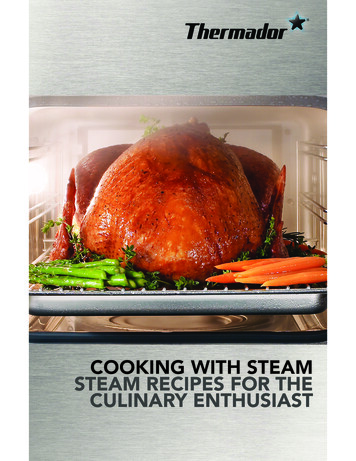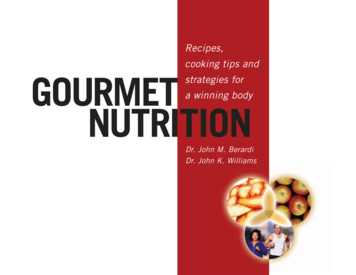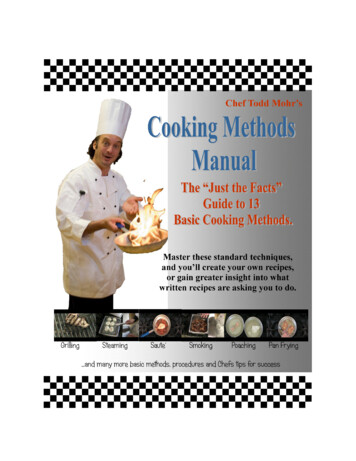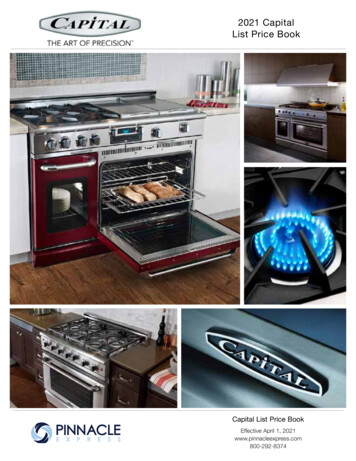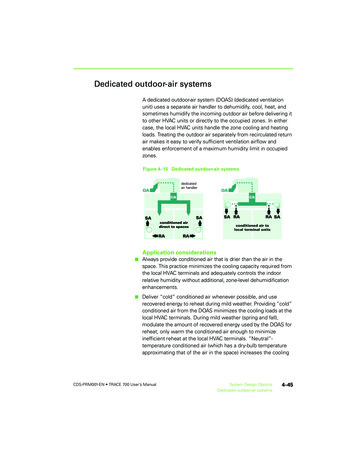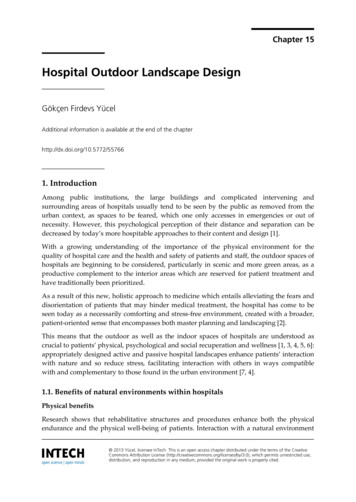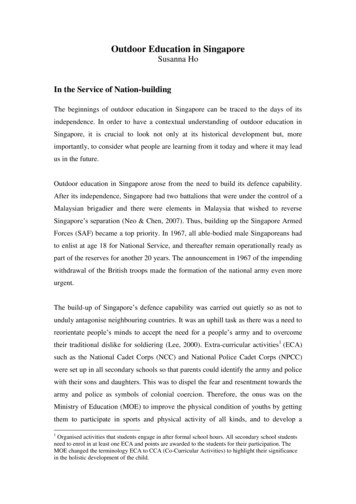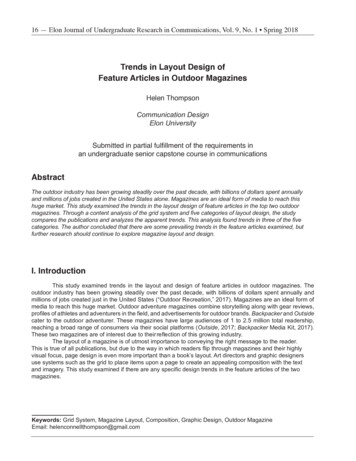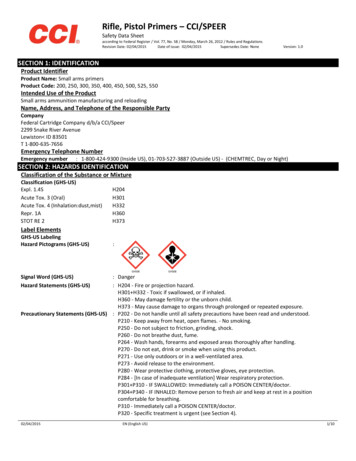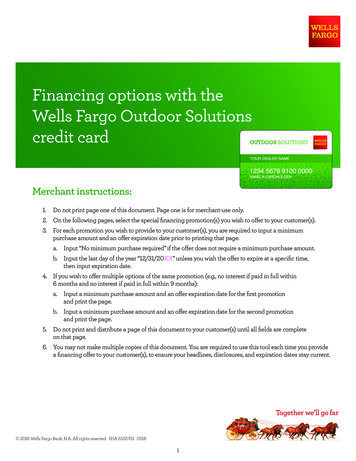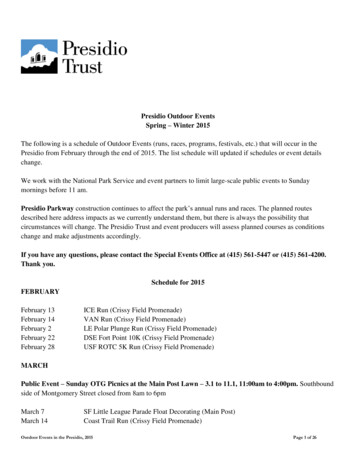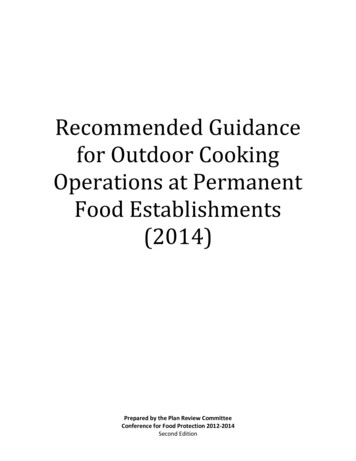
Transcription
Recommended Guidancefor Outdoor CookingOperations at PermanentFood Establishments(2014)Prepared by the Plan Review CommitteeConference for Food Protection 2012-2014Second Edition
TABLE OF CONTENTSPREFACE .3DEFINITIONS .3INTRODUCTION.4PLAN REVIEW AND APPLICATION PROCESS .4SUPPORT SERVICES PROVIDED BY THE PERMANENT FOOD ESTABLISHMENT .5LOCATION OF THE OUTDOOR COOKING OPERATION .5STRUCTURAL REQUIREMENTS FOR OUTDOOR COOKING OPERATIONS.5Premises. 5Overhead Protection. 5Walls. 6Floors . 6Equipment. 6Handwashing Facilities. 6Warewashing Facilities . 7Ventilation and Fire Protection. 7Lighting. 7Garbage. 8Toilet Facilities . 8Food Defense . 8OPERATIONAL REQUIREMENTS FOR OUTDOOR COOKING OPERATIONS.8Handwashing. 8Hygiene . 8No Bare Hand Contact . 9Food Preparation . 9Temperature Measuring Device . 9Cooking Temperatures. 9Reheating . 9Holding Temperatures . 9Food Display. 10Cleaning & Sanitizing. 10Food & Utensil Storage . 10APPENDIX IOutdoor Cooking Operations Plan Review ChecklistOutdoor Cooking Operations-Final 7.15.14Page 2 of 10
PREFACEThis document is intended to assist regulatory authorities and the food industry inunderstanding the review, approval, and operation of an Outdoor Cooking Operation that isfully supported by a Permanent Food Establishment. However, it does not establishregulatory requirements and the recommendations contained herein are not intended tosupplant, or otherwise serve as, the rules and regulations applicable to food establishmentsin a given Federal, State, local, or tribal jurisdiction.This document: Describes effective processes for reviewing plans and applications for outdoorcooking operations. Is intended as a training tool for individuals responsible for conducting plan reviewsand is used in Food and Drug Administration (FDA) -sponsored training courses onPlan Review. It is intended to be consistent with the recommendations of the FDA as contained inthe FDA 2009 Food Code. The FDA Food Code contains requirements forsafeguarding public health and ensuring food is that is unadulterated and honestlypresented when offered to the consumer. Terminology with respect to the word“shall” is based on recommendations within the FDA Food Code. Was developed by the Conference for Food Protection’s Plan Review Committee toreplace the 2003 Recommended Guidance for Permanent Outdoor CookingEstablishments document.DEFINITIONSThe following definitions may be referenced along with the definition of a FoodEstablishment as defined in the FDA Food Code.Permanent Food Establishment (PFE) means a food establishment operating in apermanently constructed structure permitted and operated for the purpose of storing,preparing, serving, packaging, or otherwise handling food at the retail level. This does notinclude a Temporary Food Establishment or Mobile Food Establishment.Outdoor Cooking Operation (OCO) means a cooking operation that is operated inconjunction with a properly permitted and approved food establishment but is not locatedwithin the fully enclosed permanent food establishment.Permanently Installed Outdoor Cooking Operation (POCO) means a cooking operationthat has permanently installed equipment and facilities and is operated in conjunction witha properly permitted and approved food establishment.Portable Outdoor Cooking Equipment (POCE) means a movable cooking operation thatis conducted on equipment that is suitably designed and maintained for use out of doorsand is operated on the same premises as, and in conjunction with, a Permanent FoodEstablishment.Time/Temperature Control for Safety Food (TCS) means a food that requirestemperature controls to limit pathogenic microorganism growth or toxin growth. Refer tothe FDA Food Code for the complete definition.Outdoor Cooking Operations-Final 7.15.14Page 3 of 10
INTRODUCTIONThe cooking of foods outdoors and the enjoyment of outdoor food events is part of alongstanding tradition in this country and worldwide. Today, across the United States,many food operators and consumers wish to continue providing and enjoying outdoorcooking and dining experiences. Geographically and environmentally, there are many areasof the country where a year-round permanent outdoor cooking operation (POCO) isfeasible and where seasonal outdoor cooking operations are safely conducted.It is essential that the equipment and physical facility requirements be based upon a menureview of the items to be prepared, cooked, held, and served. Many of these outdoorcooking operations are high risk operations engaging in extensive preparation of rawingredients with processes that include cooking, hot and cold holding, and reheating ofpotentially hazardous foods.OCOs present unique challenges depending on the type of cooking equipment andinfrastructure proposed to be utilized outdoors, including adequate access to utilities at theoutdoor site. OCOs can be operated safely when they are in compliance with well-definedregulatory standards that are established to control and minimize the contributing factorsof foodborne disease identified above. For the purpose of this document, the term“permanent” used in conjunction with outdoor cooking establishments refers to a cookingset-up that is operated by a permanent food establishment that has been approved for foodpreparation and service.The minimum guidelines set forth in this document for cooking foods outdoors areextracted from, or consistent with, the requirements of the U.S. Public Health Service, Foodand Drug Administration’s 2009 Food Code (hereafter referred to as the Food Code).These guidelines provide the basis on which regulatory authorities can evaluate and permitoutdoor cooking operations.PLAN REVIEW AND APPLICATION PROCESSPlans may be required to be submitted to the regulatory authority for review and approvalbefore a change of food operation, which would include the addition or installation of apermanent outdoor food operation (2009 Food Code § 8-201.11, 8-201.12) and must be inaccordance with all applicable local, state, and federal statues, regulations, and ordinances,including but not limited to, fire, building, and zoning codes.The plans and specifications for an OCO should include all the information necessary, suchas outlined in this document, to demonstrate conformance with, and an understanding of,food safety provisions. The pre-operational review provides the opportunity to discussareas of concern and should be conducted prior to the issuance of a permit or approval ofoutdoor cooking operations.Outdoor cooking operations that are fully compliant with the Food Code may not requireany variances. However, upon completion of a plan review, the regulatory authority maydetermine that a variance request is necessary based on the type of proposed operation,proposed menu items or proposed equipment, or may limit the menu based upon theOutdoor Cooking Operations-Final 7.15.14Page 4 of 10
limitations of the OCO – the same as any other food operation.SUPPORT SERVICES PROVIDED BY THE PERMANENT FOODESTABLISHMENTAn OCO shall be operated in conjunction with a permitted/licensed permanent foodestablishment that will provide “support services” for the outdoor cooking operation.Support services may include, but are not limited to, a variety of services such as: thesupply of potable water; the availability of adequate plumbing and waste disposal; storageand preparation facilities for food products (including refrigeration and cooking facilities);storage and cleaning facilities for equipment and utensils; storage and maintenance ofother supplies; and personnel resources. The permanent food establishment must be ofsuch size and scope as to accommodate its own operation, as well as support the needs ofthe OCO.The scope of support services should be determined at the time of plan review and bebased on the menu, the number of anticipated customers, the frequency of the outdoorcooking operation, and the limitations of the OCO. The permanent food establishment musthave a Certified Food Manager who is responsible for the overall operation of both thepermanent food establishment and the OCO.LOCATION OF THE OUTDOOR COOKING OPERATIONThe Outdoor Cooking Operation must be located in an area that allows convenient and easyaccess to the support services provided by the permanent food establishment. Safe andprotected transportation of food, equipment, utensils, and other items from the permanentfood establishment used for support services to the OCO must be evaluated.STRUCTURAL REQUIREMENTS FOR OUTDOOR COOKING OPERATIONSStructural requirements must be evaluated based on the proposed type of outdoor cookingoperation. For example a Permanent Outdoor Cooking Operation (POCO) may warrantadditional structural requirements as compared to Portable Outdoor Cooking Equipment(POCE).PremisesAll usual and customary public health risks must be evaluated when assessing an outdoorcooking operation with the additional consideration of exterior environmental factors. Thestructural requirements for the outdoor site depend on the nature of the food preparationand service. Greater structural protection is required if food is being prepared, held, and/orserved at the outdoor site. Protection may include isolation from waste disposal, sewageand rainwater runoff locations, maintenance of vegetation, and effective ongoing pestmanagement initiatives.Overhead Protectiona. Each individual piece of cooking and hot and cold holding equipment must beseparately covered (cooker top, chafing dish lid, etc.) or have overhead protection.Examples of acceptable overhead protection are roofs or other permanent structures,Outdoor Cooking Operations-Final 7.15.14Page 5 of 10
canopies, awnings, or table-type umbrellas that have met all state/local fire codes thatdictate what materials are suitable to be located above cooking equipment.Subsequently, canopies and awnings may not be suitable for use over frying or grillingoperations that generate airborne grease. (§§ 6-202.16, 6-201.12, 3-305.11)b. Protection of individual food containers may still be necessary even if a canopy or otherprotective structure is provided. If tables or other food contact surfaces are used whencutting, slicing, washing, portioning, or otherwise preparing food items, then a roof orother permanent overhead protection would be required over these areas to protectthe food. (§3-305.14, 3-306.12)Wallsa. If cooking and hot and cold holding equipment are separately covered, walls m
reheating of previously cooked and cooled foods is done at the OCO, the equipment must be . capable of heating to the minimum temperatures and times specified in Section 3-403.11. A continuous, consistent heat source such as that from gas or electric cooking equipment is preferred over wood or charcoal. The local fire safety authority must approve all outdoor cooking devices. Handwashing .
